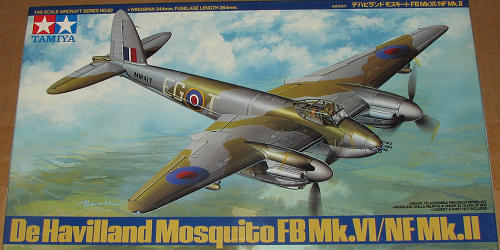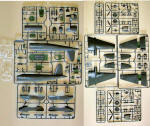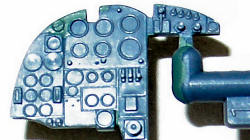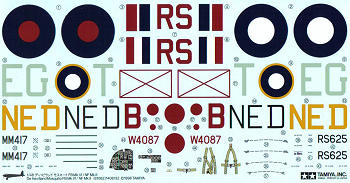
Tamiya 1/48 Mosquito FB.VI/NF.II
| KIT #: | 61062 |
| PRICE: | $40.00 MSRP |
| DECALS: | Three options |
| REVIEWER: | John Doerr |
| NOTES: | 124 parts |

| HISTORY |
I do not believe that any other aircraft has gone from being unwanted and rejected to mastering so many roles. The de Haviland concept of building a light bomber from non-strategic materials (wood) was rejected when initially proposed. The reasoning behind the concept that was pound for pound, wood is as strong as aluminum, there were adequate supplies and an army of skilled workers available. The company did not accept the rejection and continued with the project, building the prototype at its own expense. The flight trials completely vindicated the concept and a true wonder weapon was born.
The Mosquito went from an unarmed light bomber to
fighter-bomber, night fighter, strike fighter, photo reconnaissance and full
fledged bomber able to carry a 4,000 pound bomb.
In all the roles thrust upon it, the wooden wonder
excelled.
It became a special irritant to Herman Goering, and as far
as I know the only allied aircraft that rated a unique and special effort by the
Luftwaffe to combat it.
If imitation is the sincerest compliment, then the
decision to have Dr. Kurt Tank build a German Moskito (Ta 154) is the highest
praise imaginable.
While a superb performer, the Mossie was not invulnerable.
If caught by single engine fighters it could be
vanquished, but usually only if the fighters had height and speed in hand.
A special stripped version of He 219 night fighter
was built to combat the nocturnal Mosquitoes.
I know of no other allied aircraft that commanded
the single-minded effort to defeat it.
If that was not enough, part of the technology developed to build the Mosquito lives on today. According to one author, a special two-part glue was developed to bind the plywood sheets that formed a large part of the airplane. This was the first known use of Epoxy.
| THE KIT |
 I
guess the first thing to say is the kit is by Tamiya.
It comes in the standard Tamiya tray and lid box, containing eight
trees. The
trees were coded A through G.
Tree E is a double while Tree B and C each contain all the parts for
the right and left wings and the corresponding stabilizers.
Trees B and C were combined in a single bag, as were both E trees.
The rest of the trees were bagged singly.
The lay out of parts shows that a great deal of thought and planning
went into this kit.
The fuselage halves and most of major fuselage pieces are on tree A.
As stated above each wing is on it’s own tree. The engine nacelles are
on tree D.
Tree E contains the landing gear and weapons, while Tree F is the clear parts.
Tree G contains the nose section and cockpit parts.
I
guess the first thing to say is the kit is by Tamiya.
It comes in the standard Tamiya tray and lid box, containing eight
trees. The
trees were coded A through G.
Tree E is a double while Tree B and C each contain all the parts for
the right and left wings and the corresponding stabilizers.
Trees B and C were combined in a single bag, as were both E trees.
The rest of the trees were bagged singly.
The lay out of parts shows that a great deal of thought and planning
went into this kit.
The fuselage halves and most of major fuselage pieces are on tree A.
As stated above each wing is on it’s own tree. The engine nacelles are
on tree D.
Tree E contains the landing gear and weapons, while Tree F is the clear parts.
Tree G contains the nose section and cockpit parts.
The moldings are precise, delicate and flash free.
The exterior features recessed details.
The level of detail
 is exactly
what we have come to expect from Tamiya.
The cockpit is wonderfully detailed and virtually eliminates the need
for after market improvements.
is exactly
what we have come to expect from Tamiya.
The cockpit is wonderfully detailed and virtually eliminates the need
for after market improvements.
Three options are contained in the kit with weapon loads
appropriate to each version.
The day fighter FB IV includes four 500-pound bombs, two on wing
pylons and two in the bomb bay.
The bomb bay doors are in one piece.
You will need to cut them to display them open.
Only the aft half was used in the FB IV.
The forward half contained the cannons and Tamiya includes the
breeches, which are visible if you choose to open the back half.
The bomb bay roof is beautifully detailed, with fuselage tanks, which
form part of the roof, nicely molded in. There are eight rockets for the Coastal
Command version, which was the standard load.
For the night fighter version none of the flashed over holes in the
wings are opened and radar antenna/aerials are included
There are two sets of wing tips featuring clear navigation
light lenses.
One set has two forward facing lights while the other has both forward and
rearward lights.
The set with the four lights is for the Coastal Command strike-fighter
version.
The instructions are multi-page, accordion folded with
Tamiya’s standard international pictorial style drawings.
There are a couple of spots that require some studying to understand
the exact procedure that you need to follow.
They also include three three-view profiles and a 1/48 scale four-view
of the option A Mosquito.
There is a major mistake in the profiles.
Option B is a Coastal Command strike-fighter from RAF Number 625
Squadron shown with a dark gray top and deck tan undersides, coded NE*D.
A little research into 625 Squadron revealed that they were part of
Bomber Command and flew  proper
colors should be Extra Dark Sea Gray and Sky.
proper
colors should be Extra Dark Sea Gray and Sky.
Decals
The decal sheet is fairly comprehensive and includes the markings for all three versions as well stenciling. It also includes the appropriate belts and harnesses for both the pilot’s and navigator’s positions. Tamiya supplies decals for main and center console instrument panels. These are printed white on black for the whole panel, unlike some of their other offerings, which have just the gauge faces on a clear backing. Having had issues with Tamiya decals in the past I intend to replace as many as possible.
| CONCLUSIONS |
If I every found a kit that is a must have this is it.
The attention to detail and the apparent precision makes this a kit in
a class by itself.
It reminds me of another Tamiya kit that I got, not because I was a
big fan of the airplane but to complete my collection.
Once started I could not stop because it was such a pleasure to build.
Those are my expectations for this kit.
I have gone through every other manufacturer’s release of the Mosquito
in this scale and they had seemed quite good.
This kit makes them seem positively lame in comparison.
I guess it’s like test-driving a Ferrari then driving home in the
family car.
If you want a Mosquito then this is the kit for you.
Definitely recommended
| REFERENCES |
Mosquito In Action, Part 1, Jerry Scutts, Squadron/Signal Publications
Mosquito In Action, Part 2, Jerry Scutts, Squadron/Signal Publications
http://en.wikipedia.org/wiki/De_Havilland_Mosquito
http://www.mossie.org/Mosquito.html
http://gallery.kitmaker.net/showgallery.php?cat=22909
I wish to thank my partner, Susan Csaba and Peter O. Johnson for all their help in reviewing and editing
If you would like your product reviewed fairly and quickly, please contact me or see other details in the Note to Contributors.